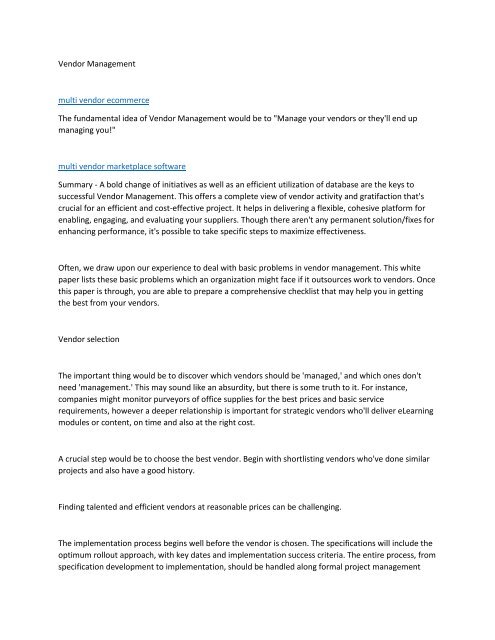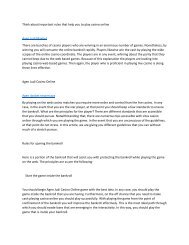Vendor Management6
Create successful ePaper yourself
Turn your PDF publications into a flip-book with our unique Google optimized e-Paper software.
<strong>Vendor</strong> Management<br />
multi vendor ecommerce<br />
The fundamental idea of <strong>Vendor</strong> Management would be to "Manage your vendors or they'll end up<br />
managing you!"<br />
multi vendor marketplace software<br />
Summary - A bold change of initiatives as well as an efficient utilization of database are the keys to<br />
successful <strong>Vendor</strong> Management. This offers a complete view of vendor activity and gratifaction that's<br />
crucial for an efficient and cost-effective project. It helps in delivering a flexible, cohesive platform for<br />
enabling, engaging, and evaluating your suppliers. Though there aren't any permanent solution/fixes for<br />
enhancing performance, it's possible to take specific steps to maximize effectiveness.<br />
Often, we draw upon our experience to deal with basic problems in vendor management. This white<br />
paper lists these basic problems which an organization might face if it outsources work to vendors. Once<br />
this paper is through, you are able to prepare a comprehensive checklist that may help you in getting<br />
the best from your vendors.<br />
<strong>Vendor</strong> selection<br />
The important thing would be to discover which vendors should be 'managed,' and which ones don't<br />
need 'management.' This may sound like an absurdity, but there is some truth to it. For instance,<br />
companies might monitor purveyors of office supplies for the best prices and basic service<br />
requirements, however a deeper relationship is important for strategic vendors who'll deliver eLearning<br />
modules or content, on time and also at the right cost.<br />
A crucial step would be to choose the best vendor. Begin with shortlisting vendors who've done similar<br />
projects and also have a good history.<br />
Finding talented and efficient vendors at reasonable prices can be challenging.<br />
The implementation process begins well before the vendor is chosen. The specifications will include the<br />
optimum rollout approach, with key dates and implementation success criteria. The entire process, from<br />
specification development to implementation, should be handled along formal project management
lines. From the outset, there has to be a task Board that will undertake to complete vendor evaluation.<br />
This Project Board should also have overall responsibility for the implementation from the project,<br />
otherwise all the knowledge gained-and decisions made-during the seller selection is possibly lost.<br />
The work Board should contain perhaps a maximum of five managers who have the most to gain and,<br />
therefore, will take a keen curiosity about the work. Almost certainly, there must be representation<br />
from Personnel/Human Resources.<br />
After you have found several technology-based vendors that interest you, gain as much basic<br />
information about them as possible. Visit their Web site, interact with them and review the work they<br />
do.<br />
Once an initial narrow your search of perhaps 4 to 6 vendors has been developed, the very first task is to<br />
compare the various approaches from all of these vendors and finalizing on the best possible option. A<br />
mandatory criteria is the budget and the confidence the vendor has in meeting implementation dates.<br />
What you need to be looking for is the way the vendor communicates an understanding of your<br />
requirements and how these requirements is going to be met, along with the way in which the vendor<br />
associates deal with questions in the Board. Among the selection criteria can be-do you feel confident<br />
with the seller team?<br />
Some other key considerations are:<br />
o Experience: The number of projects have they completed which are similar in size, scope, or content<br />
to yours?<br />
o Strength of Company: Do they have the savings and staff size to complete any project and keep it later<br />
on?<br />
o Quality of labor: They have received professional awards, published articles in trade magazines, or else<br />
been renowned for their work?<br />
o Resources: Does the vendor have full-time, on-site staff for all critical project tasks?<br />
Based on Sue Welch, CEO of Trade Stone Software, a developer of global sourcing and supplies systems<br />
in Gloucester, MA, "Wherever possible, provide value to your vendors when you are asking them to<br />
adapt to your business needs and requirements," she advises. "For instance, if you want electronic
invoicing, offer incentives such as prompt payment or instantaneous audit that can auto-correct invoice<br />
discrepancies before submission."<br />
o Figure out how well a vendor will solve problems in your project. This is never easy. In the end, any<br />
vendor will tell you it has excellent problem-solving skills. Here are a few questions you should ask<br />
prospective vendors that will help to let you know how well they can really deal with problems:<br />
1. Do you know the issues that you have come across while working on similar projects in the past?<br />
2. How have you deal with those problems?<br />
3. Have you manage to finish any project on time?<br />
4. Had you been in a position to complete any project inside the sanctioned budget?<br />
o Value addition -- Search for vendors who think beyond their assignments and may add more value to<br />
their projects. That which you do not want is someone doing what they are told to complete, just<br />
because it's a area of the Media standards.<br />
o Create a Triumph Relationship using the <strong>Vendor</strong><br />
We don't want to wield a large stick to beat up vendors, but we want to create relationships that allow<br />
both parties to operate successfully in the long term. Developing a triumph relationship with the vendor<br />
is required for good results.<br />
Below are great tips for creating a positive relationship with vendors:<br />
Tip #1: Proposal Process<br />
o The Request for an offer is detailed in its specifications.
o Together with prices, proposals specify the amount and quality of the press, interactivity, and content.<br />
o A fantastic option would be judged on the quality of the firm's work, strength of the company,<br />
dedication to customer support, price, and excellence of the proposal, itself.<br />
Tip #2: Just one Point of Contact:<br />
There must be only one point of contact who coordinates between you and the vendor - the Project<br />
Manager/Project Lead. Though each project has assigned associates, miscommunication becomes likely<br />
when several folks are talking with different amounts of each organization. For instance, when the client<br />
is experiencing a technical glitch or bug, it might make sense for the client's technical support personnel<br />
to speak directly using the vendor's most advanced programmer. However, the work manager from the<br />
client and vendor should participate in this meeting or telephone call to make sure that prior<br />
commitments or expectations are understood, action items decided, and timetables are positioned.<br />
This will help in filtering right and clear information.<br />
Tip #3: Regular evaluation through progress meetings:<br />
After this simple checklist will help improve teamwork on a project. The seller should be reviewed at<br />
regular intervals so that all the troubles are solved in the initial stage. One can meet a couple of times a<br />
week on the project at the with time with the vendor and discuss the project status. It can also include<br />
regular telephone calls using the vendor and client. Over these meetings, one can evaluate the projects<br />
and make changes if needed. Also discuss the next phase and an update on the schedule. In-between,<br />
one can also make frequent calls towards the vendor to re-check if the vendor needs any information<br />
and that things are on schedule. This prevents the work moving smoothly.<br />
Tip #4: Updated Project Report:<br />
Regular updating from the project schedule should be maintained. The report could be a simple chart<br />
that's frequently updated so that one is aware of the missed deadlines or early deadlines. This will allow<br />
you to plan at an initial phase so as to overcome delays. As you behave as a mediator between your<br />
client and also the vendor, you need to give a buffer before quoting a timeline towards the client.<br />
Tip #5: Try and make all revisions on the prototype:
The prototype is really a working module that includes the major sections of each part of any project.<br />
We should try to work with this prototype, get the initial approvals and refine the look, the feel, and also<br />
the usability from the interface. Examine, test, change, and eventually approve the colors, fonts, menu<br />
structure, location from the navigation buttons, and interface metaphors. The interface should be<br />
approved and locked-in before an essential part of the script is finished therefore the writers will have<br />
an accurate feeling of screen space while allocating text and specifying graphics.<br />
Tip #6: Make all content revisions in the script:<br />
After the prototype, the next major step from the production team is the script or storyboard. It is very<br />
important to review the language, pictures, and sounds which will come in the final program. Many<br />
clients give merely a cursory glance at this document and then end up requesting substantial changes<br />
following the content has been implemented. It is very time-consuming and expensive to change<br />
content after it is implemented in the program. Unless there are obvious typos or mistakes in grammar,<br />
revisions to content after it's implemented should be avoided.<br />
o Improved <strong>Vendor</strong> Performance -- Transparency of the project between your vendor is very crucial. It<br />
may also help you discover how to create and leverage opportunities to improve vendor performance.<br />
o Get that which you pay for - It is crucial that the vendor offers the product/quality which was decided<br />
on and is your requirement. The above mentioned tip helps you achieve it.<br />
o Just to remind you -- never accept vendors at face value. Analyze and test them at the level to build a<br />
positive business relationship.<br />
o Also recognize that while you expect value you spend with a vendor, the seller is also in the business<br />
to make a profit and has to cover overhead expenses that won't seem obvious to you or your staff.<br />
Always let your vendor know you are interested in a mutually profitable relationship.<br />
o Use your vendor representatives like a source of information and advice. However, be respectful of<br />
the time the vendor's representative spends with you. Remember that time is money for of you.<br />
o Pay attention to your vendors -- Companies may be wasting their energy when they put specific<br />
segments of the business to bid. Instead, Verticalnet's Habig suggested that better strategic answers are
achievable when companies let their vendors invest in the various components of the business they<br />
want the most.<br />
Popular features of <strong>Vendor</strong> Management:<br />
o Helps streamline, simplify and standardize your workforce processes<br />
o Allows you to increase vendor quality, helping you are making better-informed workforce decisions<br />
o Enhances efficiency helping you manage risk<br />
o Reduces costs by assisting you lower vendor rates, eliminate maverick spending and manage<br />
headcount to budget<br />
o Enables you to focus on strategic human resource functions without the problem of managing E-<br />
learning modules/application

















